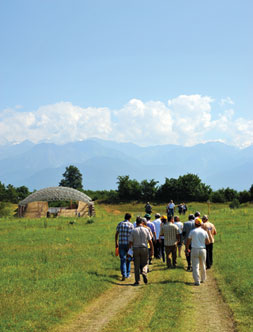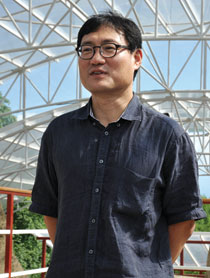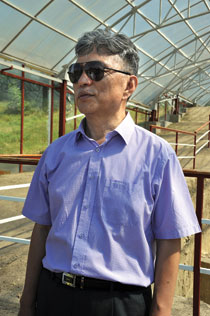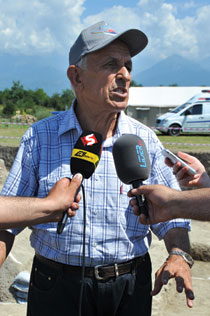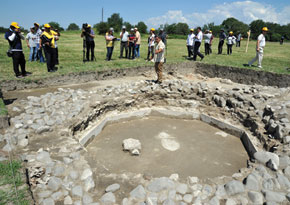Qabala in north-western Azerbaijan combines stunning scenery with a rich history and culture. The region was a centre of Caucasian Albania – a state that existed until the 8th century AD and at one time covered most of the territory of the modern-day Azerbaijan Republic. There is a wealth of archaeological material from Qabala during different periods in the life of Caucasian Albania. The first archaeological expedition here started in 1967 and continued until 1990. It discovered three distinct sites of the town of Qabala: the early town, Salbir and Qala. Archaeological research resumed several years ago with the support of Azerbaijani-Korean organization SEBA. The most recent research has lifted the curtain on the history of this region.
A conference to present the latest findings was held on 15 June in the Archaeological Centre in Chukhur Qabala at the heart of the excavations. A representative of SEBA (Seoul-Baku) Azerbaijan- Korean Cultural Exchange Association, Irada Najafova, recalled that a joint Azerbajani-Korean Archaeological Expedition had been set up in 2009. It is studying the three historical sites of Qabala as well as material from the Paleolithic Age through to the early centuries AD. A combined team from the Azerbaijan National Academy of Sciences’ Institute of Archaeology and Ethnography, Seoul National University, Chungbuk National University, Hanshin University, Hanseo University and other Korean institutes have made an in-depth study of the excavations at Chukhur Qabala.
This year the team has studied 1500 square metres dating back to classical antiquity. They discovered finds from the 3rd to 2nd centuries BC, including pottery and other household items. Three sections of 1st to 11th century Salbir were studied in particular and parts of the defensive system, various buildings including private houses, pools, water pumps and sewerage systems, graves and catacombs were discovered. Ceramics and jewellery were also found. The various discoveries are in keeping with the level of urbanization expected in the 1st to 11th centuries. Some of the finds have been sent to laboratories for further examination, while the remaining finds are on display at the Archaeological Centre in Chukhur Qabala.
During the event a group of archaeologists, journalists and representatives of SEBA and the Korean Embassy in Azerbaijan visited the excavation sites to see the work under way. Summarising the work of the joint expedition, Kim Jongil, a professor from Seoul National University, said that the main mission was to study Qabala’s northern gates and how they were built.
During the excavations we found out that the gates had been built on the basis of older ones that date to the early years AD. The developing technologies of the time were used in their construction. In future we plan to make a comparative analysis with gates of a similar age from different parts of Europe.
Choi Suk-inn, ambassador of the Republic of Korea to Azerbaijan, welcomed the work of the Azerbajan-Korea Archaeological Expedition.
I’m here not only as ambassador, but as a former history student. So I have great interest in archaeology. This is my fourth time in Qabala and it is a real pleasure to meet my former colleagues, professors from universities in Seoul, here. I have to say that this is a good example of the mutual cooperation between Korea and Azerbaijan. The joint expedition has enjoyed success. I think this cooperation will have a positive impact on other areas of relations between the two countries as well. And I’m always ready to support this process. Prof. Ilyas Babayev of Azerbaijan’s Institute of Archaeology and Ethnography said that much valuable material had been gathered from Salbir. Despite the fact that archaeological excavations started in Soviet times, he described the most recent period under SEBA’s organization as the most productive. The professor also gave interesting details of their discoveries about Caucasian Albania.
Based on the material collected, Caucasian Albania can be considered a developed state during different periods of its existence. Town planning in particular developed rapidly. Qabala was first mentioned as one of the main fortified cities of Albania – Kabalaka (Albanae Cabalaca) – by Pliny in the middle of the 1st century AD in his encyclopaedic Natural History. The formation of the state and close contacts with other parts of the world had a strong impact on all areas of life of the people of Caucasian Albania. Trade had been global since the Hellenistic era and Caucasian Albania joined the system of world trade. China was involved in these trade routes at the end of the 2nd century BC which resulted in the great Silk Road. One of the busiest branches of this route passed through Caucasian Albania, along the western coast of the Caspian Sea.
Another find highlighted by Prof. Babayev was the discovery of traces of roofing shingle in the excavations. The archaeologists were able to establish that roofing shingle was used in Qabala from the 3rd century BC and fired brick from the 1st century BC.
It’s very interesting because in China, for example, roofing shingle was not used until much later than in Caucasian Albania. Of no less interest is the wide use of coins. Yet the oldest coins found in Azerbaijan are coins from Alexander the Great. Caucasian Albania itself started to mint silver coins at the beginning of the 3rd century BCE, which were like imitation coins of Alexander the Great. Both local and imported coins were widely used in the markets of Albania.
Seals, jewellery, ornaments and ceramics found in Chukhur Qabala show the influence of both local and outside cultures. Prof. Babayev concluded that the unique culture of Caucasian Albania was formed on the basis of local traditions mixed with incoming ideas.
(For more on this subject, see Prof. Babayev’s article, The Ancient Town of Qabala Revealed by Archaeological Excavation, in the March-June 2012 issue of Visions of Azerbaijan or on our website, visions.az)
